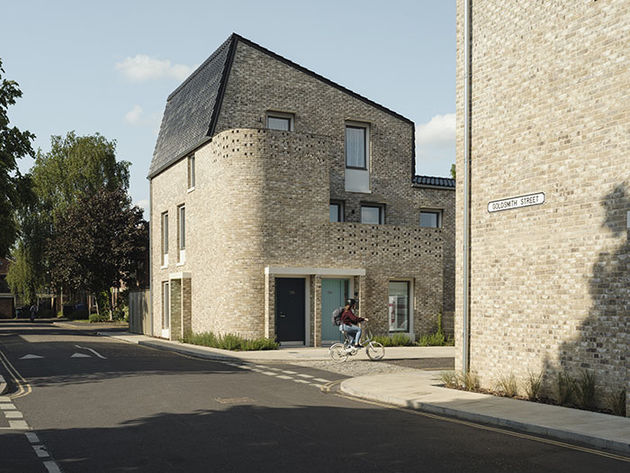 Goldsmith Street by Mikhail Riches and Cathy Hawley was awarded the 2019 RIBA Stirling Prize. Photography by Tim Crocker
Goldsmith Street by Mikhail Riches and Cathy Hawley was awarded the 2019 RIBA Stirling Prize. Photography by Tim Crocker
Mikhail Riches and Cathy Hawley’s Goldsmith Street wins the 2019 RIBA Stirling Prize and the inaugural Neave Brown Award for Housing as architects confront environmental and housing crises.
When the 2019 Stirling Prize shortlist was announced, many of us breathed a sigh of relief. All of the nominees, from Grimshaw’s London Bridge station, Witherfod Watson Mann’s Nevill Holt Opera to Rogers Stirk Harbour and Partners’ Macallan distillery, engage with sustainability on one level or another, either implicitly, as is the case with a train station and building conservation projects, or more explicitly by using low impact materials or building systems.
It is unsurprising that the winner of this year’s award for Britain’s best building is Mikhail Riches Architects and Cathy Hawley’s Goldsmith Street in Norwich, which not only aims to be sustainable sustainability – its 100 homes are built to a Passivhaus standard, drastically reducing their energy consumption – but by virtue of being a council housing scheme contributes to tackling the country’s growing property crisis. It is for this reason that the project has also won the inaugural RIBA Neave Brown Award for the country’s best affordable housing scheme.
Comprising two-storey terraces bookended by three-storey flats, the scheme wears its environmental credentials lightly. The walls may be 600mm thick, and the roofs shaved off at 15 degrees to allow the low winter sun into properties across the street, but the scheme’s overall urban massing and layout has been inspired by Norwich’s Golden Triangle, a nearby, popular area of Victorian houses. The houses are, however, thoroughly contemporary, with generously sized windows, rounded corners, perforated brick balustrades and cleverly integrated bin stores – a detail that is often the downfall of many a new, otherwise thoughtful housing developments.
 Goldsmith Street is the largest Passivhaus development in the UK. Photography by Tim Crocker
Goldsmith Street is the largest Passivhaus development in the UK. Photography by Tim Crocker
It is equally admirable that the council has been able to build such a high-quality scheme at all in an era of central government cuts and borrowing restrictions that have only recently been lifted. Passivhaus rules are incredibly stringent, and there are very few corners that can be cut. The residents will no doubt appreciate the impressive 70% reduction in energy bills, but what they will cherish just as much is living in a well-designed, familiar-looking, even aspirational environment. Given the pervasive, negative image of social housing in the UK, this can only be applauded.
Often, it looks as though the British government is not serious about tackling the housing crisis, as made clear by a recent speech by the Minister of State of Housing of Planning who praised ‘3D architects, 3D visionaries doing it with on a computer’ [sic] and the inclusion of Vitruvian principles of architecture in its National Design Guide. In all fairness, the same document did include Goldsmith Street as a piece of exemplary contemporary housing and there are further signs of progress. For example, consultation on a Future Homes Standard – which will tighten environmental and hopefully space standards – is imminent.
In the meantime, British architecture celebrates the best project of this past year – a finely-wrought, environmentally-friendly social housing scheme. Works such as this, brilliant as they are, should not too often be the pinnacle of architectural output. They should be a good standard to aim for in the future – and it would be a damning indictment of the planning system, the lack of central government support and the liberalised housing market should Mikhail Riches’ feat be repeated too often.
















